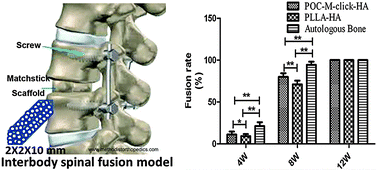A fast degradable citrate-based bone scaffold promotes spinal fusion
Abstract
It is well known that high rates of fusion failure and pseudoarthrosis development (5–35%) are concomitant in spinal fusion surgery, which was ascribed to the shortage of suitable materials for bone regeneration. Citrate was recently recognized to play an indispensable role in enhancing osteoconductivity and osteoinductivity, and promoting bone formation. To address the material challenges in spinal fusion surgery, we have synthesized mechanically robust and fast degrading citrate-based polymers by incorporating N-methyldiethanolamine (MDEA) into clickable poly(1,8-octanediol citrates) (POC-click), referred to as POC-M-click. The obtained POC-M-click were fabricated into POC-M-click–HA matchstick scaffolds by forming composites with hydroxyapatite (HA) for interbody spinal fusion in a rabbit model. Spinal fusion was analyzed by radiography, manual palpation, biomechanical testing, and histological evaluation. At 4 and 8 weeks post surgery, POC-M-click–HA scaffolds showed optimal degradation rates that facilitated faster new bone formation and higher spinal fusion rates (11.2 ± 3.7, 80 ± 4.5 at week 4 and 8, respectively) than the poly(L-lactic acid)–HA (PLLA–HA) control group (9.3 ± 2.4 and 71.1 ± 4.4) (p < 0.05). The POC-M-click–HA scaffold-fused vertebrates possessed a maximum load and stiffness of 880.8 ± 14.5 N and 843.2 ± 22.4 N mm−1, respectively, which were also much higher than those of the PLLA–HA group (maximum: 712.0 ± 37.5 N, stiffness: 622.5 ± 28.4 N mm−1, p < 0.05). Overall, the results suggest that POC-M-click–HA scaffolds could potentially serve as promising bone grafts for spinal fusion applications.


 Please wait while we load your content...
Please wait while we load your content...